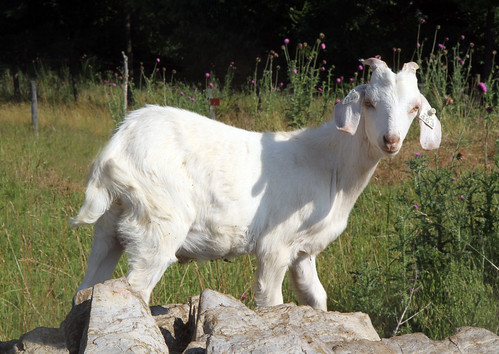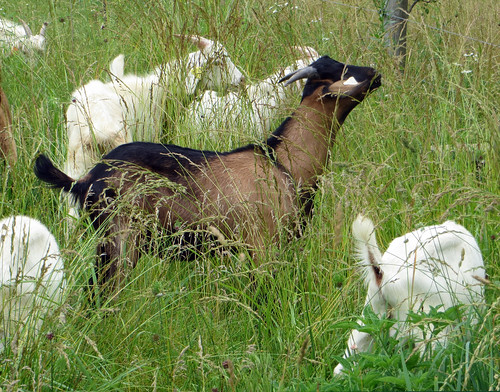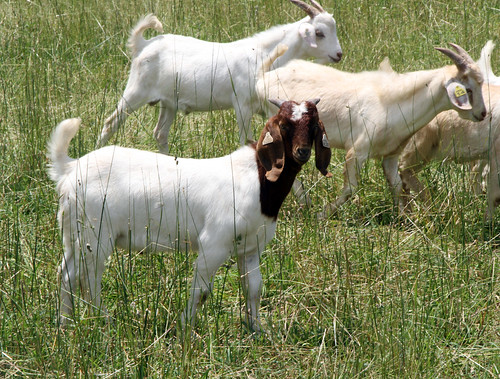There are 77 bucks in the 2014 test. All but one of the bucks is Kiko or Kiko-influenced. There are 27 New Zealand Kikos. New Zealand Kikos must be the offspring of 100% New Zealand Kikos. They must trace their ancestry to the original Kikos that were imported into the US (from New Zealand).
There are 39 Purebred Kikos. According to the breed registries, a Purebred Kiko must have at least 15/16 Kiko breeding (93.5%) to be classified as Kiko. There are three Percentage Kikos. Percentage Kikos must be at least 50% Kiko and be the offspring of a 100% New Zealand or purebred Kiko buck or doe.
Most of the Kiko bucks in the test are eligible for registry in one or more of the Kiko registries: AKGA, IKGA, or NKR. The only Boer buck in the test can be registered in any of the Boer registries. Only seven of the bucks in the test are ineligible for registration. Most of these are crossbreds. Crossbred bucks make excellent sires for commercial herds.
On-farm data
The Detailed Buck Report provides on-farm performance data for the 77 bucks in the test. The report is for informational purposes only. It is important that the data only be compared among bucks in the same consignment. Differences between consignments are mostly the result of different production environments, especially nutrition.
For example, creep feeding and high quality forages will likely result in heavier weaning weights and pre-weaning ADG. But, differences between animals in different herds are not genetic. The only way to compare weaning weights of animals in different herds is to calculate EBVs (estimated breeding values). Otherwise, comparisons are limited mostly to on-farm comparisons.
Birth weight
Birth weight (BW) is influenced by many factors, including late gestation nutrition and age of dam. Among the 77 bucks in the test, birth weight ranged from 4.8 to 10.6 lbs. and averaged 7.2 ± 1.3 lbs. When birth weights were adjusted for birth type and age of dam, the weight range was 4.6 to 10.9 lbs. and the average adjusted birth weight was 7.6 ± 1.4 lbs. Older and younger does tend to give birth to lighter kids. Birth weight is also obviously affected by birth type, with twins and triplets being lighter than single-births.
Weaning weight
Weaning weight (WW) is influenced by many factors, including type of birth and rearing, age of dam, and nutrition. Thirty-seven percent (n=29) of the bucklings in the test were creep fed. Creep feeding is when supplemental feed, usually grain, is offered to suckling kids. Sixty-five percent of the dams (84.4%) received supplemental feed during lactation. Supplemental feeding is often necessary to meet the nutritional requirements of lactating does, especially young does and those nursing multiple births. It may result in heavier weaning weights, due to improved milk production.
Actual weaning weights ranged from 27.0 to 58.1 lbs. and averaged 41.3 ± 7.5 lbs. When adjusted to a common age (90 days), weaning weights ranged from 22.9 to 71.7 lbs. and averaged 45.0 + 9.1 lbs. When adjusted for sex, type of birth and rearing, and age of dam, weaning weights ranged from 24.3 to 86.1 lbs. and averaged 49.0 ± 11.4 lbs.
Weaning weight ratios
Some consignors were able to provide weaning weight ratios. A weaning weight ratio shows how a buck compares to his contemporaries. It is calculated by dividing his weaning weight by the average weaning weight in the contemporary group. A contemporary group is a group of animals of similar ages that have been fed and managed the same.
Among the bucks with weaning weight ratios, ratios ranged from 94 to 135 percent and averaged 108 ± 10 percent. In the future, we would like to have weaning weight ratios on all the bucks in the test. In addition, some consignors may want to consider enrolling their herds in the National Sheep Improvement Program (NSIP), which calculates EBVs for sheep and goat producers.
Download Detailed Buck Report -- updated 07.07.14 --
There are 39 Purebred Kikos. According to the breed registries, a Purebred Kiko must have at least 15/16 Kiko breeding (93.5%) to be classified as Kiko. There are three Percentage Kikos. Percentage Kikos must be at least 50% Kiko and be the offspring of a 100% New Zealand or purebred Kiko buck or doe.
 |
| New Zealand Ziko, Mike Renick (WV) |
Most of the Kiko bucks in the test are eligible for registry in one or more of the Kiko registries: AKGA, IKGA, or NKR. The only Boer buck in the test can be registered in any of the Boer registries. Only seven of the bucks in the test are ineligible for registration. Most of these are crossbreds. Crossbred bucks make excellent sires for commercial herds.
On-farm data
The Detailed Buck Report provides on-farm performance data for the 77 bucks in the test. The report is for informational purposes only. It is important that the data only be compared among bucks in the same consignment. Differences between consignments are mostly the result of different production environments, especially nutrition.
For example, creep feeding and high quality forages will likely result in heavier weaning weights and pre-weaning ADG. But, differences between animals in different herds are not genetic. The only way to compare weaning weights of animals in different herds is to calculate EBVs (estimated breeding values). Otherwise, comparisons are limited mostly to on-farm comparisons.
 |
| Purebred Kiko, Kraig Stemme (TX) |
Birth weight
Birth weight (BW) is influenced by many factors, including late gestation nutrition and age of dam. Among the 77 bucks in the test, birth weight ranged from 4.8 to 10.6 lbs. and averaged 7.2 ± 1.3 lbs. When birth weights were adjusted for birth type and age of dam, the weight range was 4.6 to 10.9 lbs. and the average adjusted birth weight was 7.6 ± 1.4 lbs. Older and younger does tend to give birth to lighter kids. Birth weight is also obviously affected by birth type, with twins and triplets being lighter than single-births.
Weaning weight
Weaning weight (WW) is influenced by many factors, including type of birth and rearing, age of dam, and nutrition. Thirty-seven percent (n=29) of the bucklings in the test were creep fed. Creep feeding is when supplemental feed, usually grain, is offered to suckling kids. Sixty-five percent of the dams (84.4%) received supplemental feed during lactation. Supplemental feeding is often necessary to meet the nutritional requirements of lactating does, especially young does and those nursing multiple births. It may result in heavier weaning weights, due to improved milk production.
 |
| Full blood Boer, Christine English (MD) |
Actual weaning weights ranged from 27.0 to 58.1 lbs. and averaged 41.3 ± 7.5 lbs. When adjusted to a common age (90 days), weaning weights ranged from 22.9 to 71.7 lbs. and averaged 45.0 + 9.1 lbs. When adjusted for sex, type of birth and rearing, and age of dam, weaning weights ranged from 24.3 to 86.1 lbs. and averaged 49.0 ± 11.4 lbs.
Weaning weight ratios
Some consignors were able to provide weaning weight ratios. A weaning weight ratio shows how a buck compares to his contemporaries. It is calculated by dividing his weaning weight by the average weaning weight in the contemporary group. A contemporary group is a group of animals of similar ages that have been fed and managed the same.
Among the bucks with weaning weight ratios, ratios ranged from 94 to 135 percent and averaged 108 ± 10 percent. In the future, we would like to have weaning weight ratios on all the bucks in the test. In addition, some consignors may want to consider enrolling their herds in the National Sheep Improvement Program (NSIP), which calculates EBVs for sheep and goat producers.
Download Detailed Buck Report -- updated 07.07.14 --











